C语言函数大全 本篇介绍C语言函数大全--g开头的函数(下) 17. getmodename 17.1 函数说明 函数声明 函数功能 char * getmodename(int mode_name); 获取指定的图形模式名 17.2 演示示例 #include graphics
C语言函数大全
本篇介绍C语言函数大全--g开头的函数(下)
17. getmodename
17.1 函数说明
char * getmodename(int mode_name);
获取指定的图形模式名
17.2 演示示例
#include <graphics.h>
#include <stdlib.h>
#include <stdio.h>
int main(void)
{
int gdriver = DETECT, gmode, errorcode;
int midx, midy, mode;
char numname[80], modename[80];
initgraph(&gdriver, &gmode, "");
errorcode = graphresult();
if (errorcode != grOk)
{
printf("Graphics error: %s\n", grapherrormsg(errorcode));
printf("Press any key to halt:");
getch();
exit(1);
}
midx = getmaxx() / 2;
midy = getmaxy() / 2;
mode = getgraphmode();
sprintf(numname, "%d is the current mode number.", mode);
sprintf(modename, "%s is the current graphics mode.", getmodename(mode));
settextjustify(CENTER_TEXT, CENTER_TEXT);
outtextxy(midx, midy, numname);
outtextxy(midx, midy+2*textheight("W"), modename);
getch();
closegraph();
return 0;
}
17.3 运行结果
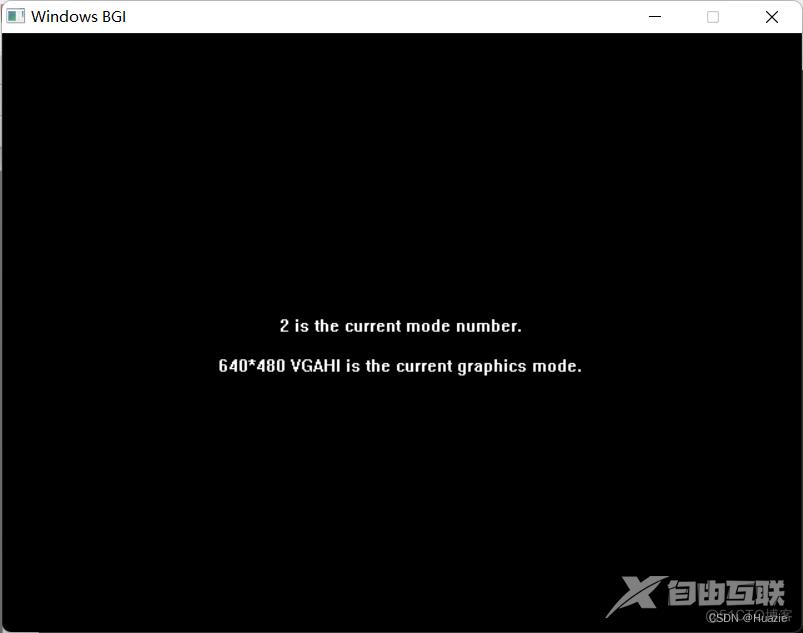
18. getmoderange
18.1 函数说明
void getmoderange(int graphdriver, int *lomode, int *himode);
获取给定图形驱动程序的模式范围
18.2 演示示例
#include <graphics.h>
#include <stdlib.h>
#include <stdio.h>
int main()
{
int gdriver = DETECT, gmode, errorcode;
int midx, midy, low, high;
char mrange[80];
initgraph(&gdriver, &gmode, "");
errorcode = graphresult();
if (errorcode != grOk)
{
printf("Graphics error: %s\n", grapherrormsg(errorcode));
printf("Press any key to halt:");
getch();
exit(1);
}
midx = getmaxx() / 2;
midy = getmaxy() / 2;
getmoderange(gdriver, &low, &high);
sprintf(mrange, "This driver supports modes %d~%d", low, high);
settextjustify(CENTER_TEXT, CENTER_TEXT);
outtextxy(midx, midy, mrange);
getch();
closegraph();
return 0;
}
18.3 运行结果
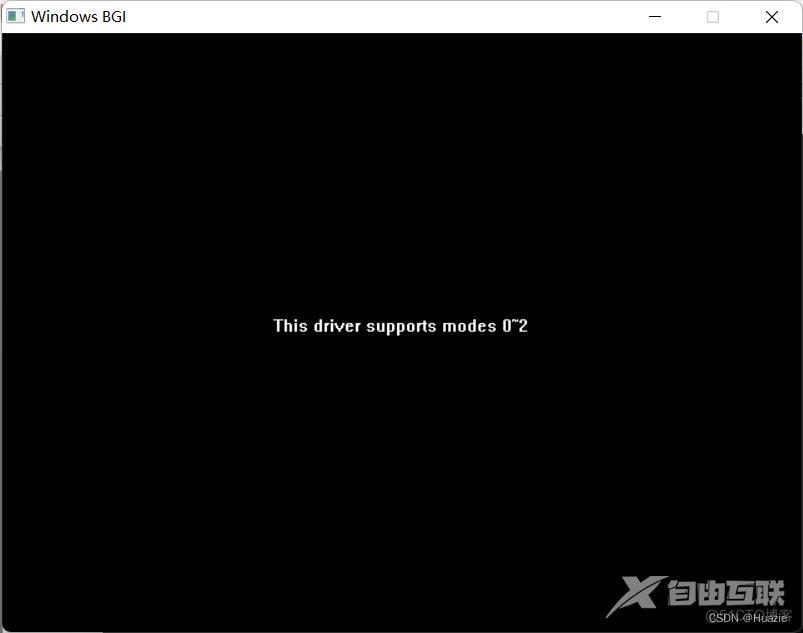
19. getpalette
19.1 函数说明
void getpalette(struct palettetype *palette);
获取有关当前调色板的信息
19.2 演示示例
#include <graphics.h>
#include <stdlib.h>
#include <stdio.h>
int main()
{
int gdriver = DETECT, gmode, errorcode;
struct palettetype pal;
char psize[80], pval[20];
int i, ht;
int y = 10;
initgraph(&gdriver, &gmode, "");
errorcode = graphresult();
if (errorcode != grOk)
{
printf("Graphics error: %s\n", grapherrormsg(errorcode));
printf("Press any key to halt:");
getch();
exit(1);
}
getpalette(&pal);
sprintf(psize, "The palette has %d modifiable entries.", pal.size);
outtextxy(0, y, psize);
if (pal.size != 0)
{
ht = textheight("W");
y += 2*ht;
outtextxy(0, y, "Here are the current values:");
y += 2*ht;
for (i=0; i < pal.size; i++, y+=ht)
{
sprintf(pval, "palette[%02d]: 0x%02X", i, pal.colors[i]);
outtextxy(0, y, pval);
}
}
getch();
closegraph();
return 0;
}
19.3 运行结果
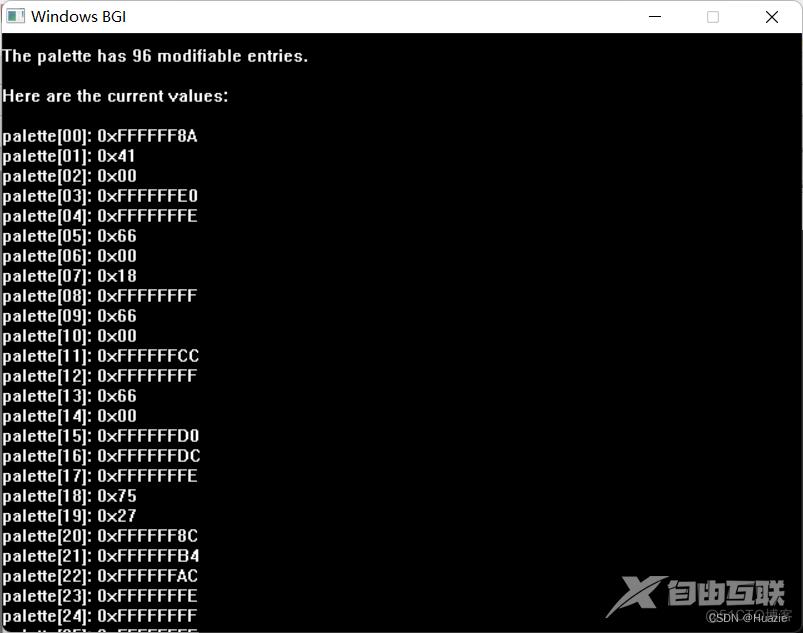
20. getpixel
20.1 函数说明
int getpixel(int x, int y);
获取得指定像素的颜色
20.2 演示示例
#include <graphics.h>
#include <stdlib.h>
#include <stdio.h>
#include <time.h>
#define PIXEL_COUNT 1000
#define DELAY_TIME 100
int main(void)
{
int gdriver = DETECT, gmode, errorcode;
int midx, midy, x, y, color, maxx, maxy, maxcolor;
char mPixel[50];
initgraph(&gdriver, &gmode, "");
errorcode = graphresult();
if (errorcode != grOk)
{
printf("Graphics error: %s\n", grapherrormsg(errorcode));
printf("Press any key to halt:");
getch();
exit(1);
}
midx = getmaxx() / 2;
midy = getmaxy() / 2;
maxx = getmaxx() + 1;
maxy = getmaxy() + 1;
maxcolor = getmaxcolor() + 1;
while (!kbhit())
{
srand((unsigned)time(NULL));
x = rand() % maxx;
y = rand() % maxy;
color = rand() % maxcolor;
putpixel(x, y, color);
sprintf(mPixel, "color of pixel at (%d,%d) = %d", x, y, getpixel(x, y));
settextjustify(CENTER_TEXT, CENTER_TEXT);
outtextxy(midx, midy, mPixel);
delay(DELAY_TIME);
cleardevice();
}
getch();
closegraph();
return 0;
}
20.3 运行结果

21. gets
21.1 函数说明
'\0' 空字符,并由此来结束字符串。
注意: gets 函数可以无限读取,易发生溢出。如果溢出,多出来的字符将被写入到堆栈中,这就覆盖了堆栈原先的内容,破坏一个或多个不相关变量的值。
21.2 演示示例
#include <stdio.h>
int main()
{
char string[80];
printf("Input a string:");
gets(string);
printf("The string input was: %s\n", string);
return 0;
}
21.3 运行结果
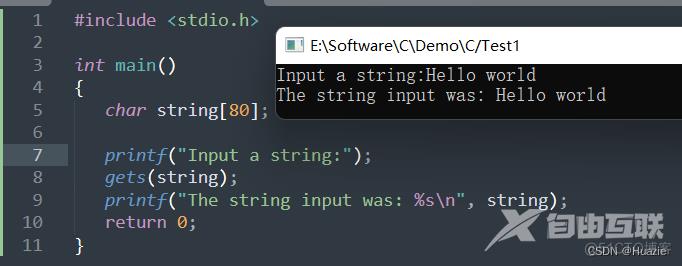
22. gettextsettings
22.1 函数说明
void gettextsettings(struct textsettingstype *textinfo);
获取有关当前图形文本字体的信息
22.2 演示示例
#include <graphics.h>
#include <stdlib.h>
#include <stdio.h>
#include <conio.h>
// 文本字体
char *font[] = { "DEFAULT_FONT",
"TRIPLEX_FONT",
"SMALL_FONT",
"SANS_SERIF_FONT",
"GOTHIC_FONT"
};
// 文本方向
char *dir[] = { "HORIZ_DIR", "VERT_DIR" };
// 文本水平对齐方式
char *hjust[] = { "LEFT_TEXT", "CENTER_TEXT", "RIGHT_TEXT" };
// 文本垂直对齐方式
char *vjust[] = { "BOTTOM_TEXT", "CENTER_TEXT", "TOP_TEXT" };
int main()
{
int gdriver = DETECT, gmode, errorcode;
struct textsettingstype textinfo;
int midx, midy, ht;
char fontstr[80], dirstr[80], sizestr[80];
char hjuststr[80], vjuststr[80];
initgraph(&gdriver, &gmode, "");
errorcode = graphresult();
if (errorcode != grOk)
{
printf("Graphics error: %s\n", grapherrormsg(errorcode));
printf("Press any key to halt:");
getch();
exit(1);
}
midx = getmaxx() / 2;
midy = getmaxy() / 2;
// 获取有关当前图形文本字体的信息
gettextsettings(&textinfo);
sprintf(fontstr, "%s is the text style.", font[textinfo.font]);
sprintf(dirstr, "%s is the text direction.", dir[textinfo.direction]);
sprintf(sizestr, "%d is the text size.", textinfo.charsize);
sprintf(hjuststr, "%s is the horizontal justification.", hjust[textinfo.horiz]);
sprintf(vjuststr, "%s is the vertical justification.", vjust[textinfo.vert]);
ht = textheight("W");
settextjustify(CENTER_TEXT, CENTER_TEXT);
outtextxy(midx, midy, fontstr);
outtextxy(midx, midy+2*ht, dirstr);
outtextxy(midx, midy+4*ht, sizestr);
outtextxy(midx, midy+6*ht, hjuststr);
outtextxy(midx, midy+8*ht, vjuststr);
getch();
closegraph();
return 0;
}
22.3 运行结果
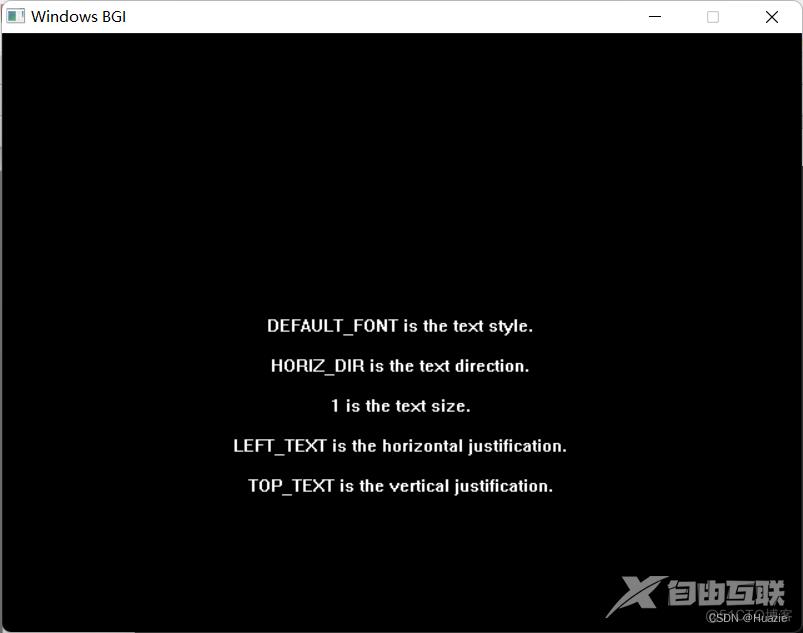
23. getviewsettings
23.1 函数说明
void getviewsettings(struct viewporttype *viewport);
获取有关当前视区的信息
23.2 演示示例
#include <graphics.h>
#include <stdlib.h>
#include <stdio.h>
char *clip[] = { "OFF", "ON" };
int main()
{
int gdriver = DETECT, gmode, errorcode;
struct viewporttype viewinfo;
int midx, midy, ht;
char topstr[80], botstr[80], clipstr[80];
initgraph(&gdriver, &gmode, "");
errorcode = graphresult();
if (errorcode != grOk)
{
printf("Graphics error: %s\n", grapherrormsg(errorcode));
printf("Press any key to halt:");
getch();
exit(1);
}
midx = getmaxx() / 2;
midy = getmaxy() / 2;
// 获取有关当前视区的信息
getviewsettings(&viewinfo);
sprintf(topstr, "(%d, %d) is the upper left viewport corner.", viewinfo.left, viewinfo.top);
sprintf(botstr, "(%d, %d) is the lower right viewport corner.", viewinfo.right, viewinfo.bottom);
sprintf(clipstr, "Clipping is turned %s.", clip[viewinfo.clip]);
settextjustify(CENTER_TEXT, CENTER_TEXT);
ht = textheight("W");
outtextxy(midx, midy, topstr);
outtextxy(midx, midy+2*ht, botstr);
outtextxy(midx, midy+4*ht, clipstr);
getch();
closegraph();
return 0;
}
23.3 运行结果
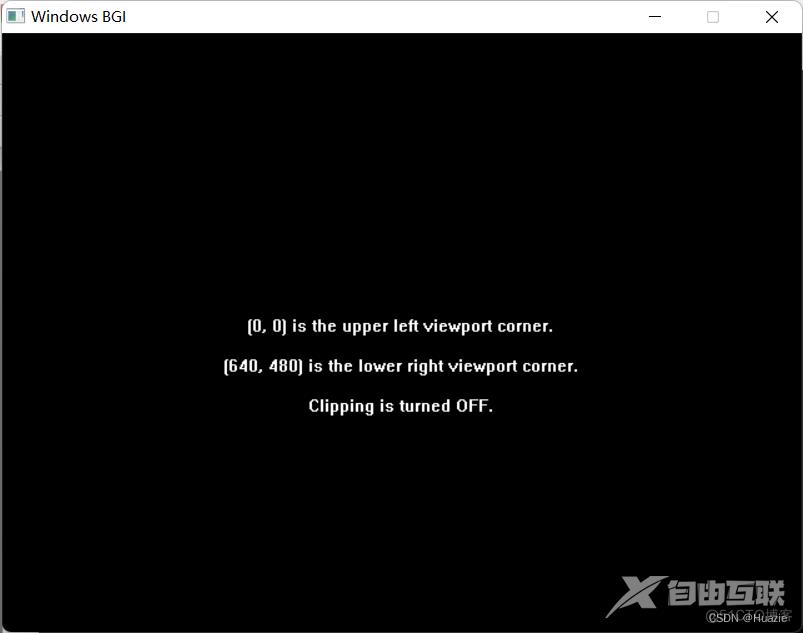
24. getw
24.1 函数说明
int getw(FILE *strem);
从 stream 所指向文件读取下一个整数
24.2 演示示例
#include <stdio.h>
#include <stdlib.h>
#define FNAME "test.txt"
int main(void)
{
FILE *fp;
int word;
fp = fopen(FNAME, "wb");
if (fp == NULL)
{
printf("Error opening file %s\n", FNAME);
exit(1);
}
word = 94;
putw(word,fp);
if (ferror(fp))
printf("Error writing to file\n");
else
printf("Successful write\n");
fclose(fp);
fp = fopen(FNAME, "rb");
if (fp == NULL)
{
printf("Error opening file %s\n", FNAME);
exit(1);
}
word = getw(fp);
if (ferror(fp))
printf("Error reading file\n");
else
printf("Successful read: word = %d\n", word);
fclose(fp);
unlink(FNAME);
return 0;
}
24.3 运行结果
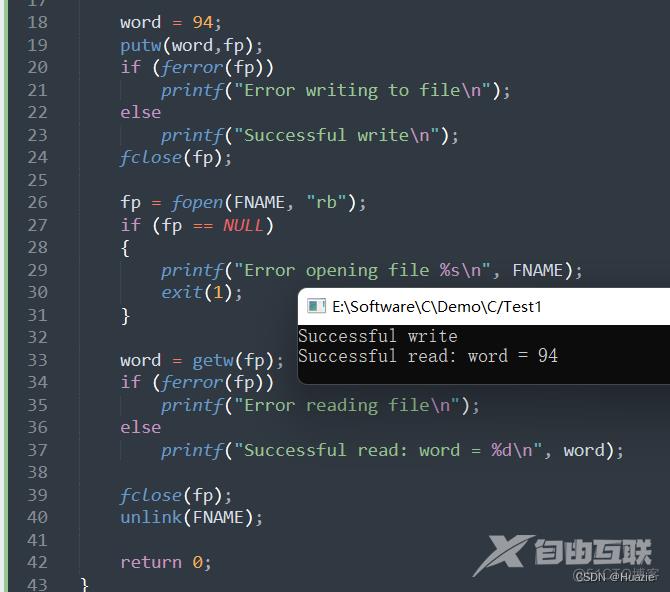
25. getx,gety
25.1 函数说明
int getx(void);
获取当前图形位置的 x 坐标
获取当前图形位置的 y 坐标
25.2 演示示例
#include <graphics.h>
#include <stdlib.h>
#include <stdio.h>
int main(void)
{
int gdriver = DETECT, gmode, errorcode;
char msg[80];
initgraph(&gdriver, &gmode, "");
errorcode = graphresult();
if (errorcode != grOk)
{
printf("Graphics error: %s\n", grapherrormsg(errorcode));
printf("Press any key to halt:");
getch();
exit(1);
}
moveto(getmaxx() / 2, getmaxy() / 2);
sprintf(msg, "<-(%d, %d) is the here.", getx(), gety());
outtext(msg);
getch();
closegraph();
return 0;
}
25.3 运行结果
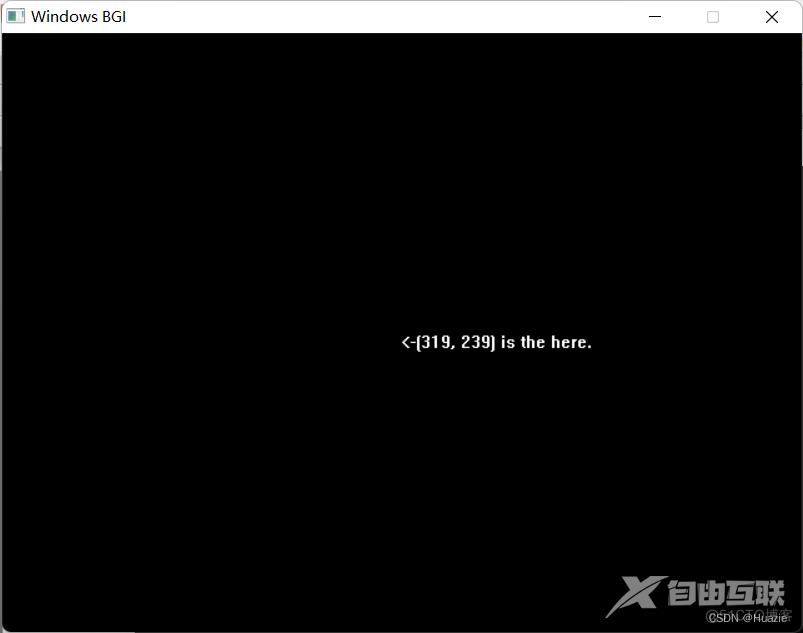
26. gmtime
26.1 函数说明
struct tm *gmtime(long *clock);
把日期和时间转换为格林尼治标准时间(GMT)
26.2 演示示例
#include <stdio.h>
#include <stdlib.h>
#include <time.h>
#include <dos.h>
// 太平洋标准时间和夏令时
char *tzstr = "TZ=PST8PDT";
int main(void)
{
time_t t;
struct tm *gmt, *area;
putenv(tzstr); // 用来改变或增加环境变量的内容
tzset(); // UNIX时间兼容函数
// 获取当前的系统时间,其值表示从协调世界时(Coordinated Universal Time)
// 1970年1月1日00:00:00(称为UNIX系统的Epoch时间)到当前时刻的秒数。
t = time(NULL);
area = localtime(&t); // 把从1970-1-1零点零分到当前时间系统所偏移的秒数时间转换为本地时间
// asctime 把timeptr指向的tm结构体中储存的时间转换为字符串
printf("Local time is: %s", asctime(area));
// 把日期和时间转换为格林尼治标准时间(GMT)
gmt = gmtime(&t);
printf("GMT is: %s", asctime(gmt));
return 0;
}
26.3 运行结果

27. graphdefaults
27.1 函数说明
void graphdefaults(void);
将所有图形设置复位为它们的缺省值
27.2 演示示例
#include <graphics.h>
#include <stdlib.h>
#include <stdio.h>
#include <conio.h>
int main(void)
{
int gdriver = DETECT, gmode, errorcode;
int maxx, maxy;
initgraph(&gdriver, &gmode, "c:\\bor\\Borland\\bgi");
errorcode = graphresult();
if (errorcode != grOk)
{
printf("Graphics error: %s\n", grapherrormsg(errorcode));
printf("Press any key to halt:");
getch();
exit(1);
}
maxx = getmaxx();
maxy = getmaxy();
setlinestyle(DOTTED_LINE, 0, 3);
line(0, 0, maxx, maxy);
outtextxy(maxx/2, maxy/3, "Before default values are restored.");
getch();
// 将所有图形设置复位为它们的缺省值
graphdefaults();
cleardevice();
line(0, 0, maxx, maxy);
outtextxy(maxx/2, maxy/3, "After restoring default values.");
getch();
closegraph();
return 0;
}
27.3 运行结果
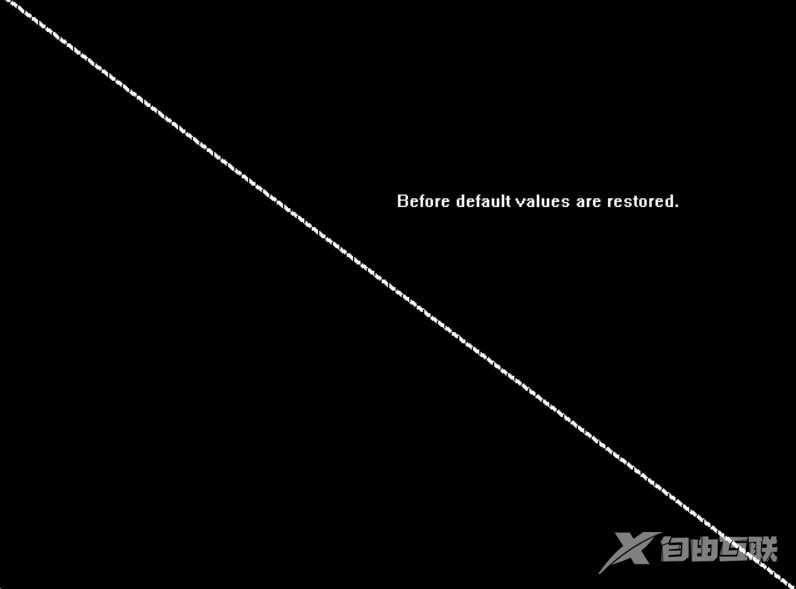
28. grapherrormsg
28.1 函数说明
char * grapherrormsg(int errorcode);
返回一个错误信息串的指针
28.2 演示示例
#include <graphics.h>
#include <stdlib.h>
#include <stdio.h>
#define NONSENSE -50
int main(void)
{
// FORCE AN ERROR TO OCCUR
int gdriver = NONSENSE, gmode, errorcode;
initgraph(&gdriver, &gmode, "");
errorcode = graphresult();
if (errorcode != grOk)
{
printf("Graphics error: %s\n", grapherrormsg(errorcode));
printf("Press any key to halt:");
getch();
exit(1);
}
line(0, 0, getmaxx(), getmaxy());
getch();
closegraph();
return 0;
}
28.3 运行结果
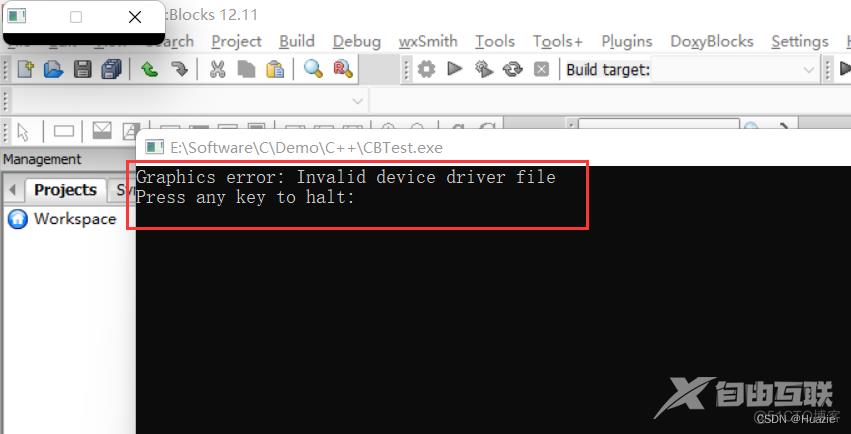
29. graphresult
29.1 函数说明
int graphresult(void);
返回最后一次不成功的图形操作的错误代码
29.2 演示示例
#include <graphics.h>
#include <stdlib.h>
#include <stdio.h>
#include <conio.h>
int main(void)
{
// request auto detection
int gdriver = DETECT, gmode, errorcode;
initgraph(&gdriver, &gmode, "");
errorcode = graphresult();
if (errorcode != grOk)
{
printf("Graphics error: %s\n", grapherrormsg(errorcode));
printf("Press any key to halt:");
getch();
exit(1);
}
line(0, 0, getmaxx(), getmaxy());
getch();
closegraph();
return 0;
}
29.3 运行结果
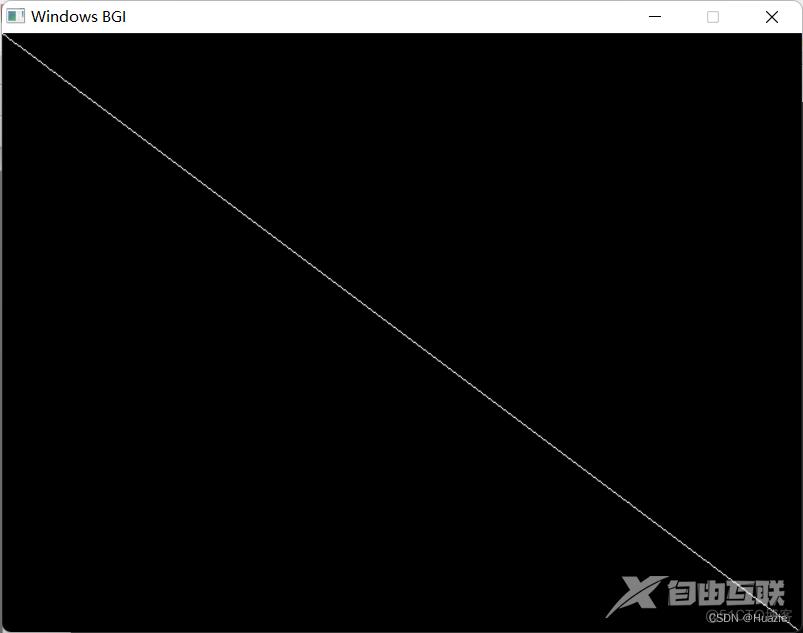
30. getmaxwidth,getmaxheight
30.1 函数说明
int getmaxwidth(void);
获取屏幕的最大宽度
int getmaxheight(void);
获取屏幕的最大高度
30.2 演示示例
#include <graphics.h>
#include <stdlib.h>
#include <stdio.h>
int main()
{
int gdriver = DETECT, gmode, errorcode;
int midx, midy;
char ch[80];
initgraph(&gdriver, &gmode, "");
errorcode = graphresult();
if (errorcode != grOk)
{
printf("Graphics error: %s\n", grapherrormsg(errorcode));
printf("Press any key to halt:");
getch();
exit(1);
}
midx = getmaxx() / 2;
midy = getmaxy() / 2;
sprintf(ch, "maxwidth = %d, maxheight = %d", getmaxwidth(), getmaxheight());
settextjustify(CENTER_TEXT, CENTER_TEXT);
outtextxy(midx, midy, ch);
getch();
closegraph();
return 0;
}
30.3 运行结果
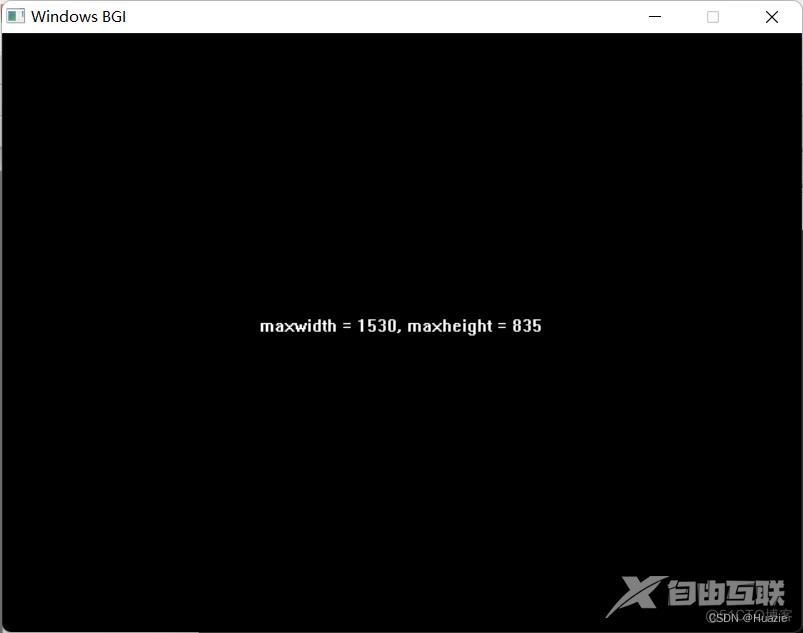
31. getdisplaycolor
31.1 函数说明
int getdisplaycolor( int color );
根据 color ,返回要显示的颜色值
注意: color = -1 , 则返回 WHITE = 15 的颜色值;color < - 1 或 color > 15,则输出一个8位整数。
31.2 演示示例
#include <graphics.h>
#include <stdlib.h>
#include <stdio.h>
int main()
{
int gdriver = DETECT, gmode, errorcode;
int midx, midy;
char ch[80];
initgraph(&gdriver, &gmode, "");
errorcode = graphresult();
if (errorcode != grOk)
{
printf("Graphics error: %s\n", grapherrormsg(errorcode));
printf("Press any key to halt:");
getch();
exit(1);
}
midx = getmaxx() / 2;
midy = getmaxy() / 2;
sprintf(ch, "color = %d, displaycolor(-1) = %d, displaycolor(16) = %d", getcolor(), getdisplaycolor(-1), getdisplaycolor(16));
settextjustify(CENTER_TEXT, CENTER_TEXT);
outtextxy(midx, midy, ch);
getch();
closegraph();
return 0;
}
31.3 运行结果
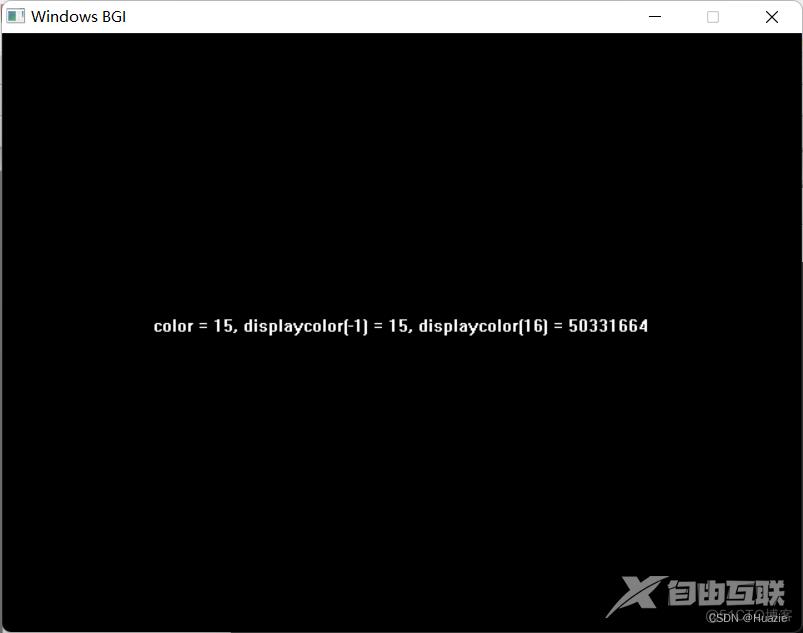
32. getwindowwidth,getwindowheight
32.1 函数说明
int getwindowwidth();
获取图形界面窗口宽度
int getwindowheight(void);
获取图形界面窗口高度
32.2 演示示例
#include <graphics.h>
#include <stdlib.h>
#include <stdio.h>
int main()
{
int gdriver = DETECT, gmode, errorcode;
int midx, midy, low, high;
char ch[80];
initgraph(&gdriver, &gmode, "");
errorcode = graphresult();
if (errorcode != grOk)
{
printf("Graphics error: %s\n", grapherrormsg(errorcode));
printf("Press any key to halt:");
getch();
exit(1);
}
midx = getmaxx() / 2;
midy = getmaxy() / 2;
sprintf(ch, "windowwidth = %d, windowheight = %d", getwindowwidth(), getwindowheight());
settextjustify(CENTER_TEXT, CENTER_TEXT);
outtextxy(midx, midy, ch);
getch();
closegraph();
return 0;
}
32.3 运行结果
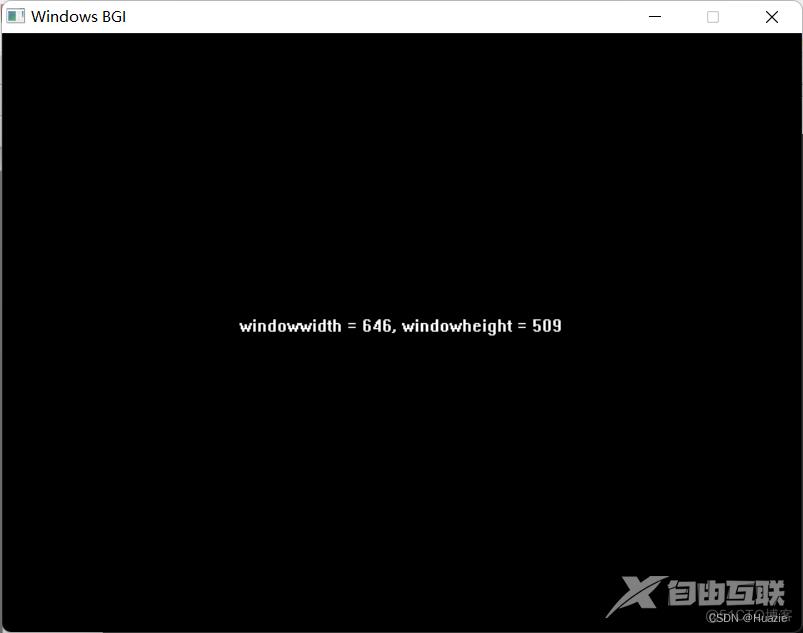
33. getrefreshingbgi
33.1 函数说明
bool getrefreshingbgi(void);
获取刷新基础图形界面标识
33.2 演示示例
#include <graphics.h>
#include <stdlib.h>
#include <stdio.h>
int main()
{
int gdriver = DETECT, gmode, errorcode;
int midx, midy, low, high;
char ch[80];
initgraph(&gdriver, &gmode, "");
errorcode = graphresult();
if (errorcode != grOk)
{
printf("Graphics error: %s\n", grapherrormsg(errorcode));
printf("Press any key to halt:");
getch();
exit(1);
}
midx = getmaxx() / 2;
midy = getmaxy() / 2;
sprintf(ch, "refreshingbgi = %d", getrefreshingbgi());
settextjustify(CENTER_TEXT, CENTER_TEXT);
outtextxy(midx, midy, ch);
getch();
closegraph();
return 0;
}
33.3 运行结果
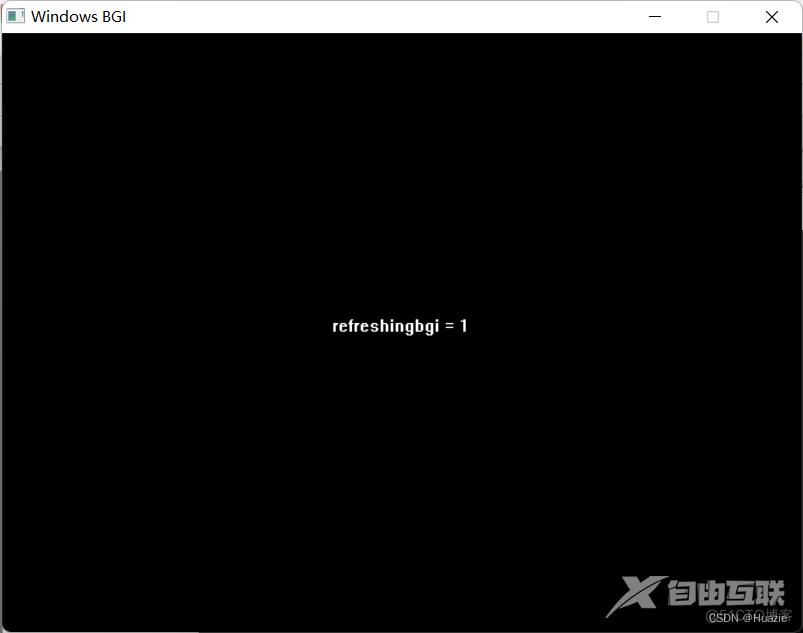
参考
- [API Reference Document]
- [gets]
